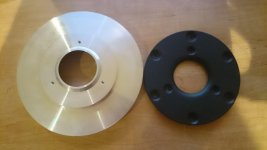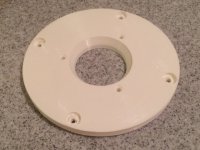Hello everyone,
After having received my XT25TG30 tweeters and Monacor WG300 waveguides, I started thinking about how to put the two together. I figured that an adapter flange would be the nicest way to do this, so I took my tweeters apart, measured them, and drew a flange in Freecad. I have attached two views of this flange.
Because the unit cost of CNC manufactured things goes down as numbers increase, I was wondering if more people than just me would like to have such a flange. If so, I could try to find a manufacturer and initiate a group buy.
Please do not PM me, but reply to this thread. Also, if you happen to know a manufacturer with good prices (preferably in the EU), let me know!
Cheers!
After having received my XT25TG30 tweeters and Monacor WG300 waveguides, I started thinking about how to put the two together. I figured that an adapter flange would be the nicest way to do this, so I took my tweeters apart, measured them, and drew a flange in Freecad. I have attached two views of this flange.
Because the unit cost of CNC manufactured things goes down as numbers increase, I was wondering if more people than just me would like to have such a flange. If so, I could try to find a manufacturer and initiate a group buy.
Please do not PM me, but reply to this thread. Also, if you happen to know a manufacturer with good prices (preferably in the EU), let me know!
Cheers!
Attachments
I don't think that anything that can be made with a router will provide the kind of fit that I am after. Most importantly, the "snout" at the back presses against the membrane edge (just like the original faceplate) and provides a 360 degrees pressure seal with the membrane. The throat of the waveguide is too rough, and the plastic is too flexible to reliably provide such a seal. So that's why I wanted a snout that perfectly matches the recess in the tweeter. The chamfer on the snout looks like it is 45 degrees, but it isn't, it is a tad steeper, and so it cannot be made accurately with a standard router bit.
The hole in the plate is another area that can't be made with a router. It isn't straight, it consists of two conical sections, of which the last one (the part ending in the snout) is dimensioned to provide a snug fit with the throat of the waveguide. In this way, a construction can be made that doesn't leak, without having to use glue.
Doing all this requires the use of a lathe and making the plate out of aluminum, because the snout would become too thin, fragile and incapable of making the desired seal when made out of wood.
It was my initial plan to turn them on my lathe, but then I figured that more people than just me might want such a plate. Would you still choose to muck with a router, if all the above can be had in a readily made, bolt-on solution and for a reasonable price?
The hole in the plate is another area that can't be made with a router. It isn't straight, it consists of two conical sections, of which the last one (the part ending in the snout) is dimensioned to provide a snug fit with the throat of the waveguide. In this way, a construction can be made that doesn't leak, without having to use glue.
Doing all this requires the use of a lathe and making the plate out of aluminum, because the snout would become too thin, fragile and incapable of making the desired seal when made out of wood.
It was my initial plan to turn them on my lathe, but then I figured that more people than just me might want such a plate. Would you still choose to muck with a router, if all the above can be had in a readily made, bolt-on solution and for a reasonable price?
Don't know if you know this, but the three screw holes that secure the faceplate to the tweeter-body on the XT25, are in the exact same location and serve the exact same purpose on a whole bunch of other Scanspeak tweeters. R2904/XXXX, D3004/XXXX, etc. etc. the list is really big.
So this adapter might be significantly more versatile than you think. I've done something similar with an SS waveguide that is pictured below. Shoutout to Xymox1 who shared this WG design with me.
So this adapter might be significantly more versatile than you think. I've done something similar with an SS waveguide that is pictured below. Shoutout to Xymox1 who shared this WG design with me.
Attachments
Timpert,
Do you have an STL file? This can be 3d printed - looks not to complicated. I would make the waveguide smoother (more rounded edges rather than sharp eddge). It is a very minimal WG. Have you seen the big one Onni made?
Do you have an STL file? This can be 3d printed - looks not to complicated. I would make the waveguide smoother (more rounded edges rather than sharp eddge). It is a very minimal WG. Have you seen the big one Onni made?
@ cocoapuffs: Yes, I know that more Tymphany and Scan Speak tweeters may fit. The plate is specific to the Monacor waveguide, as I don't hink there are others that fit. The Monacor waveguide is a proven one with the whole XT25 family of ring radiators (both Tymphany and SS), so I am actually a bit surprised that there is so little interest.
@ xrk971: 3D printing is a viable option that thus far never crossed my mind. Thanks for the tip, I will certainly look into it. The plate is only an adapter, it is designed to fit an existing (and rather affordable) waveguide, so my aim is to keep the adapter affordable as well.
@ xrk971: 3D printing is a viable option that thus far never crossed my mind. Thanks for the tip, I will certainly look into it. The plate is only an adapter, it is designed to fit an existing (and rather affordable) waveguide, so my aim is to keep the adapter affordable as well.
I would make the adapter simpler, like this one (a simple disc with shaved holes, look at the last image): 7100-waveguide
Instead of making my sample with a router I could buy a couple of 3D printed items.
Ralf
Instead of making my sample with a router I could buy a couple of 3D printed items.
Ralf
Also saw that page, but unfortunately, the waveguide throat doesn't fit into the faceplate of the XT25 when mounted like that. Perhaps the 7100 has a slightly larger aperture?
As long as 3d printing - print adapter and waveguide. Just need to model waveguide curve in 3d.
I often use plastic modeling clay to make temp waveguides. One could sculpt it and listen and measure. Once satisfied make either plaster of Paris or resin casting from sculpted model.
I often use plastic modeling clay to make temp waveguides. One could sculpt it and listen and measure. Once satisfied make either plaster of Paris or resin casting from sculpted model.
I used a 'quick and dirty' method and just filled up the area between the ridges on the rear side of the WG300 with liquid plastic used for sealing electronic circuits against water/shock/tampering.
Using screws with coarse threads and being careful not to overtighten the XT25 seemed to mount reasonably well with no further modifications to either driver or waveguide.
Not perfect by any means, but measured and sounded okay.
Using screws with coarse threads and being careful not to overtighten the XT25 seemed to mount reasonably well with no further modifications to either driver or waveguide.
Not perfect by any means, but measured and sounded okay.
Also saw that page, but unfortunately, the waveguide throat doesn't fit into the faceplate of the XT25 when mounted like that. Perhaps the 7100 has a slightly larger aperture?
It works fine for me.
@ xrk971: 3D printing is a viable option that thus far never crossed my mind. Thanks for the tip, I will certainly look into it. The plate is only an adapter, it is designed to fit an existing (and rather affordable) waveguide, so my aim is to keep the adapter affordable as well.
printing has begun...
Not sure about CNC pricing in the Netherlands but I can have those made in Bulgaria, the company I use charges me EUR1.70/meter. I am expecting to receive a pair of those waveguides in a week and have the XT25 around so may jump in for a pair of flanges.
Let's see how the 3d printed prototypes fit, if they do we might consider having some more made in whatever way we'd like.
I think it would be good to round the inner edges.
Why? The throat of the waveguide extends fully through the adapter plate, it should be flush with the snout. The snout itself is meant to provide an exact match to the recess in the dome assembly, and to keep the assembly pressed against the front pole plate at the edge of the dome, like the original faceplate does. The sound wave will not encounter any sharp edges, because it only travels along the inside surface of the waveguide and does not "see" anything of the adapter plate. The bore in the snout is conical, in order to match the outside shape of the last 4 millimeters of the waveguide's throat. It should be a snug fit.
Last edited:
That makes sense, I thought the sound wave would need to travel through your adapter and then to deploy into the WG300. I would be interested into a pair of these.
- Home
- Loudspeakers
- Multi-Way
- Waveguide adapter for XT25 and WG300, any interest?

